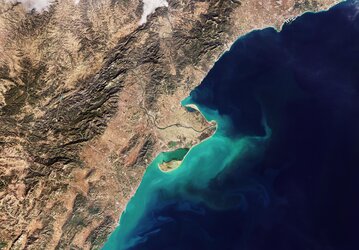Accept all cookies Accept only essential cookies See our Cookie Notice

About ESA
The European Space Agency (ESA) is Europe’s gateway to space. Its mission is to shape the development of Europe’s space capability and ensure that investment in space continues to deliver benefits to the citizens of Europe and the world.
Highlights
ESA - United space in Europe
This is ESA ESA facts Member States & Cooperating States Funding Director General Top management For Member State Delegations European vision European Space Policy ESA & EU Space Councils Responsibility & Sustainability Annual Report Calendar of meetings Corporate newsEstablishments & sites
ESA Headquarters ESA ESTEC ESA ESOC ESA ESRIN ESA EAC ESA ESAC Europe's Spaceport ESA ESEC ESA ECSAT Brussels Office Washington OfficeWorking with ESA
Business with ESA ESA Commercialisation Gateway Law at ESA Careers Cyber resilience at ESA IT at ESA Newsroom Partnerships Merchandising Licence Education Open Space Innovation Platform Integrity and Reporting Administrative Tribunal Health and SafetyMore about ESA
History ESA Historical Archives Exhibitions Publications Art & Culture ESA Merchandise Kids Diversity ESA Brand Centre ESA ChampionsLatest
Space in Member States
Find out more about space activities in our 23 Member States, and understand how ESA works together with their national agencies, institutions and organisations.
Science & Exploration
Exploring our Solar System and unlocking the secrets of the Universe
Go to topicAstronauts
Missions
Juice Euclid Webb Solar Orbiter BepiColombo Gaia ExoMars Cheops Exoplanet missions More missionsActivities
International Space Station Orion service module Gateway Concordia Caves & Pangaea BenefitsLatest
Space Safety
Protecting life and infrastructure on Earth and in orbit
Go to topicAsteroids
Asteroids and Planetary Defence Asteroid danger explained Flyeye telescope: asteroid detection Hera mission: asteroid deflection Near-Earth Object Coordination CentreSpace junk
About space debris Space debris by the numbers Space Environment Report In space refuelling, refurbishing and removingSafety from space
Clean Space ecodesign Zero Debris Technologies Space for Earth Supporting Sustainable DevelopmentLatest
Applications
Using space to benefit citizens and meet future challenges on Earth
Go to topicObserving the Earth
Observing the Earth Future EO Copernicus Meteorology Space for our climate Satellite missionsCommercialisation
ESA Commercialisation Gateway Open Space Innovation Platform Business Incubation ESA Space SolutionsLatest
Enabling & Support
Making space accessible and developing the technologies for the future
Go to topicBuilding missions
Space Engineering and Technology Test centre Laboratories Concurrent Design Facility Preparing for the future Shaping the Future Discovery and Preparation Advanced Concepts TeamSpace transportation
Space Transportation Ariane Vega Space Rider Future space transportation Boost! Europe's Spaceport Launches from Europe's Spaceport from 2012Latest

Zaragoza, Spain
Thank you for liking
You have already liked this page, you can only like it once!
The province of Zaragoza, in northeast Spain, is featured in this image captured by the Copernicus Sentinel-2 mission.
Together with the provinces of Huesca and Teruel, Zaragoza formed the old kingdom of Aragon. Its capital, also called Zaragoza (not visible in this image) is home to around half of Aragon’s population.
The Ebro River can be seen winding its way through the province from west to east in this image. Between its source in the Cantabrian Mountains in the northwest and its delta on the Mediterranean coast, the Ebro River is fed by more than 200 tributaries as it flows 910 km across much of northern Spain.
In an otherwise arid region, with scarce annual rainfall of less than 380 to 460 mm, irrigation in the Ebro basin is extremely important. The La Loteta reservoir, popular for kite surfing, was designed to regulate the flow of the Aragon Imperial Canal and is visible in turquoise in the bottom-left of the image.
Many agricultural fields in the valleys surrounding the Ebro River can be seen in the image. Cereals, especially wheat and barley, dominate the economy, followed by corn, stock raising and fruit. Different types of agricultural fields can be identified by their shapes. For example, circular shapes in the bottom-left of the image are centre-pivot irrigation fields – where equipment rotates around a central pivot and crops are watered with sprinklers.
The nearby mountains, largely devoid of vegetation, can be seen north of the river. These dry and mountainous areas are the least populated of the region.
Copernicus Sentinel-2 is based on a constellation of two identical satellites in the same orbit. Its five-day revisit frequency and its global coverage offer excellent opportunities for both regional and global agriculture monitoring. Copernicus helps assess agricultural land use and trends, crop conditions and yield forecasts. It also supports input management, farm management recording and irrigation management.
This image is also featured on the Earth from Space video programme.
-
CREDIT
contains modified Copernicus Sentinel data (2021), processed by ESA -
LICENCE
CC BY-SA 3.0 IGO or ESA Standard Licence
(content can be used under either licence)

Zaragoza, Spain

Earth from space: Zaragoza

Catalan coast, Spain

Earth from Space: Zaragoza















 Germany
Germany
 Austria
Austria
 Belgium
Belgium
 Denmark
Denmark
 Spain
Spain
 Estonia
Estonia
 Finland
Finland
 France
France
 Greece
Greece
 Hungary
Hungary
 Ireland
Ireland
 Italy
Italy
 Luxembourg
Luxembourg
 Norway
Norway
 The Netherlands
The Netherlands
 Poland
Poland
 Portugal
Portugal
 Czechia
Czechia
 Romania
Romania
 United Kingdom
United Kingdom
 Slovenia
Slovenia
 Sweden
Sweden
 Switzerland
Switzerland
























